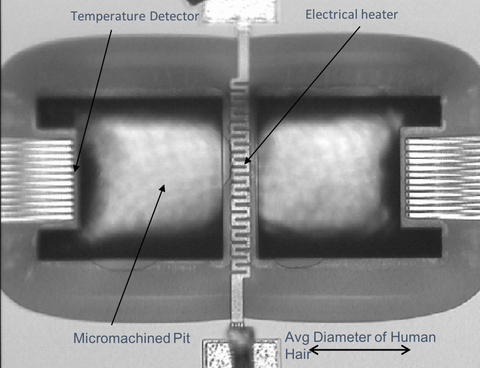Convective Accelerometer

The “convective accelerometer,” a miniature device for sensing acceleration, uses heated gas instead of solid mechanical parts.
NIST’s Michael Gaitan and his colleagues patented a new type of acceleration sensor in the late 1990s. Known as the “convective accelerometer,” it uses heated gas instead of moving solid mechanical parts. With no such moving parts, it can survive thousands of g’s of acceleration, is unaffected by unwanted vibrations, and it can be easily incorporated into computer chips.
The device contains a heating element that heats the gas around it, and works similar to what happens when tipping a candle. When the candle is vertical, the temperature on either side of the flame will be equal. However, when the candle is tipped the side that is closer to the flame will get hotter than the other side and this temperature difference is related to the angle of tilt.
In the convective accelerometer, a polysilicon heater warms up the gas. When the device experiences acceleration, the response is similar to tilting a candle: the faster the acceleration, the greater the temperature difference between the two ends of the device.
This sort of shift is also similar what happens when you put a balloon in your car. When you accelerate your car you feel like you are being pushed back into your seat, but a the balloon moves to the front of the car, which is opposite to what you might think would happen. When you decelerate the balloon moves to the back of your car. This is because buoyancy acts in the opposite direction to applied acceleration, just like even though the earth’s gravity is pulling us down, balloons want to go upwards.
The accelerometer was patented at NIST during the late 1990s and has since been used in commercial products. Among its applications is to embed it into packages and track deliveries to confirm if fragile items were handled carefully (not dropped), and the correct side was facing upwards.
Paper: V. Milanović, E. Bowen, M.E. Zaghloul, N.H. Tea, J.S. Suehle, B. Payne, and M. Gaitan, Micromachined convective accelerometers in standard integrated circuits technology. Published online January 2000. DOI: 10.1063/1.125803

